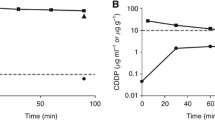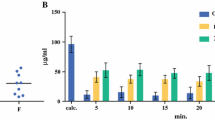Abstract
Purpose
To measure the clearance intraperitoneal mitomycin C and doxorubicin in patients having peritonectomy and analyze the impact of the extent of peritoneal resection on pharmacokinetics.
Methods
A group of 15 patients with peritoneal carcinomatosis were submitted to cytoreductive surgery and heated intraperitoneal chemotherapy. Ten patients received mitomycin C and five, doxorubicin. Six patients underwent total parietal peritonectomy and nine had less-extensive peritonectomy. Pharmacokinetics were determined by sampling peritoneal fluid and blood. Drug concentrations over time, area under the curve ratios and the amount of drug recovered from the peritoneal cavity were calculated and compared between the groups.
Results
The concentrations of mitomycin C over time in the peritoneal fluid and plasma were similar in five patients with total parietal peritonectomy as compared to five patients with less-extensive peritonectomy (P=0.5350 and 0.6991; Mann-Whitney test). Mitomycin C area under the curve ratio in total peritonectomy patients was 20.5 and 25.7 in patients with less-extensive peritonectomy. The difference in total amount of drug recovered from the peritoneal cavity was not significant (30.6±6.188% versus 22.6±3.84%, P=0.095). In the studies with doxorubicin, one patient underwent total parietal peritonectomy with similar pharmacokinetics to four patients submitted to partial peritonectomy.
Conclusions
The extent of parietal peritoneal resection did not affect the pharmacokinetics of intraoperative intraperitoneal chemotherapy. The pharmacological barrier between the abdominopelvic cavity and plasma is not directly related to an intact peritoneum.



Similar content being viewed by others
References
Bull JMC (1994) An update on the anticancer effects of a combination of chemotherapy and hyperthermia. Cancer Res 44:4853
Carmignani P, Sugarbaker T, Bromley CM, Sugarbaker PH (2003) Intraperitoneal cancer dissemination: mechanisms of the patterns of spread. Metastases Rev (in press)
Chu DZJ, Lang NP, Thompson C, Osteen PK, Westbrook KC (1989) Peritoneal carcinomatosis in nongynecologic malignancy. A prospective study of prognostic factors. Cancer 63:364
Culliford AT IV, Brooks AD, Sharma S, Saltz LB, Schwartz GK, O'Reilly EM, Ilson DH, Kemeny NE, Kelsen DP, Guillem JG, Wong D, Cohen AM, Paty PB (2001) Surgical debulking and intraperitoneal chemotherapy for established peritoneal metastases from colon and appendix cancer. Ann Surg Oncol 8:787
Dedrick RL, Flessner MF, Collins JM, Schultz JS (1982) Is the peritoneum a membrane? Am Soc Artif Intern Organs J 5:1
Den Hartigh J, Mcvie JG, Van Oort WJ, Pinedo HM (1983) Pharmacokinetics of mitomycin C in humans. Cancer Res 43:5017
Eksborgh S, Ehrsson H, Lindfors A (1983) Liquid chromatographic determination of mitomycin C in human plasma and urine. J Chromatogr B Biomed Sci Appl 274:263
Flessner M, Henegar J, Bigler S, Genous L (2003) Is the peritoneum a significant transport barrier in peritoneal dialysis? Peritoneal Dialysis International (in press)
Israel M, Pegg WJ, Wilkinson PM, Garnick MB (1978) Liquid chromatographic analysis of adriamycin and metabolites in biological fluids. J Liquid Chromatogr 1:795
Jacquet P, Sugarbaker PH (1996) Peritoneal-plasma barrier. Cancer Treat Res 82:53
Jacquet P, Stephens AD, Averbach AM, Chang D, Ettinghausen SE, Dalton RR, Steves MA, Sugarbaker PH (1996) Analysis of morbidity and mortality in 60 patients with peritoneal carcinomatosis treated by cytoreductive surgery and heated intraoperative intraperitoneal chemotherapy. Cancer 77:2622
Jacquet P, Averbach A, Stephens AD, Stuart OA, Chang D, Sugarbaker, PH (1998) Heated intraoperative intraperitoneal mitomycin C and early postoperative intraperitoneal 5-fluorouracil: pharmacokinetic studies. Oncology 55:130
Loggie BW, Fleming RA, Mcquellon RP, Russeli GB, Geisinger KR (2000) Cytoreductive surgery with intraperitoneal hyperthermic chemotherapy for disseminated peritoneal cancer of gastrointestinal origin. Am Surg 66:561
Rubin J, Jones Q, Planch A, Rushton F, Bower J (1986) The importance of the abdominal viscera to peritoneal transport during peritoneal dialysis in the dog. Am J Med Sci 292:203
Rubin J, Clawson M, Planch A, Jones Q (1988) Measurements of peritoneal surface area in man and rat. Am J Med Sci 295:453
Sadeghi B, Arvieux C, Glehen O, Beaujard AC, Rivoire M, Baulieux J, Fontaumard E, Brachet A, Caillot JL, Faure JL, Porcheron J, Peix JL, François Y, Vignal J, Gilly FN (2000) Peritoneal carcinomatosis from non-gynecologic malignancies. Results of the EVOCAPE 1 Multicentric Prospective Study. Cancer 88:358
Sugarbaker PH (1995) Peritonectomy procedures. Ann Surg 221:29
Sugarbaker PH (1998) Management of peritoneal surface malignancy using intraperitoneal chemotherapy and cytoreductive surgery. A manual for physicians and nurses, 3rd edn. The Ludann Company, Grand Rapids, MI
Sugarbaker PH (1999) Management of peritoneal-surface malignancy: the surgeon's role. Langenbecks Arch Surg 384:576
Sugarbaker PH, Chang D (1999) Results of treatment of 385 patients with peritoneal surface spread of appendiceal malignancy. Ann Surg Oncol 6:727
Sugarbaker PH, Schellinx, MT, Chang D, Koslowe P (1996) Peritoneal carcinomatosis from adenocarcinoma of the colon. World J Surg 20:585
Tjaden UR, DeBruijn EA, Vand Der Hoeven RAM, Jol C, Van Der Greef J, Lingeman H (1987) Automated analysis of mitomycin C in body fluids by high performance liquid chromatography with on line sample pre-treatment. J Chromatogr B Biomed Sci Appl 420:53
Urano M, Kuroda M, Nishimura Y (1999) For the clinical application of thermochemotherapy given at mild temperatures. Int J Hyperthermia 15(2):79
Author information
Authors and Affiliations
Corresponding author
Rights and permissions
About this article
Cite this article
de Lima Vazquez, V., Stuart, O.A., Mohamed, F. et al. Extent of parietal peritonectomy does not change intraperitoneal chemotherapy pharmacokinetics. Cancer Chemother Pharmacol 52, 108–112 (2003). https://doi.org/10.1007/s00280-003-0626-8
Received:
Accepted:
Published:
Issue Date:
DOI: https://doi.org/10.1007/s00280-003-0626-8




